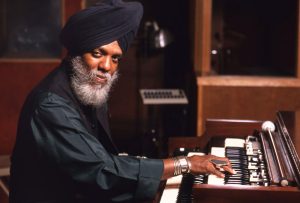Dr. Lonnie Smith (Jazz Organist)
The Doctor of Groove & Psychedelic Jazz Organ
Early Life & Background
Lonnie Smith (July 3, 1942 – September 28, 2021) was an American jazz organist known for his deep grooves, adventurous improvisation, and signature turbaned look. Born in Lackawanna, New York, Smith was drawn to music early on, influenced by gospel, blues, and rhythm & blues. Though he never formally studied music, he had an innate ability to absorb and interpret different styles, which made his approach to the Hammond B-3 organ unique.
Career & Breakthrough
Smith first gained attention in the mid-1960s as part of guitarist George Benson’s quartet. His work on Benson’s albums It’s Uptown (1966) and The George Benson Cookbook (1967) showcased his rhythmic comping and deep blues feel. These recordings led to Smith signing with Blue Note Records, where he became one of the defining voices of soul jazz.
Key Early Albums:
- Finger Lickin’ Good (1967) – His debut, packed with bluesy, swinging grooves.
- Think! (1968) – A bold mix of soul, funk, and jazz, featuring Lee Morgan and David “Fathead” Newman.
- Turning Point (1969) – A more experimental album that explored modal jazz and deep groove improvisation.
Signature Sound: Soul, Funk & Psychedelia
Dr. Lonnie Smith’s playing stood out for its raw emotion, deep swing, and adventurous spirit. He wasn’t just a jazz organist—his music blended jazz, funk, rock, and even psychedelic influences. His signature sound included:
- Groove-Heavy Bass Lines – Often playing thick, rolling bass lines with his left hand and pedals.
- Expressive Swells & Glissandos – He used volume swells, pitch bends, and slides to create dramatic, vocal-like effects.
- Funky, Stabbed Chords – Tight, rhythmic comping that locked in with the drummer.
- Psychedelic Sound Effects – Later in his career, he incorporated synthesizers and electronic effects.
Dr. Lonnie Smith’s Classic Drawbar Settings
- Upper Manual: 888000000 or 868000000
- Lower Manual: 848000000
- Percussion: ON (Soft, Fast, 3rd Harmonic)
- Vibrato/Chorus: C3 or OFF
- Leslie Speaker: Often manipulated for dramatic effect, switching speeds mid-phrase for added expressiveness.
Notable Recordings
Blue Note Era (1967-1970)
During his time at Blue Note, Smith recorded some of the most groove-heavy organ albums of the era:
- Think! (1968) – A funk-infused jazz session that became one of his classics.
- Turning Point (1969) – Showcased his modal and improvisational depth.
- Drives (1970) – A fusion of jazz, funk, and psychedelia.
Mid-Career: Funk & Fusion (1970s-1990s)
Smith embraced funk and fusion influences in the ’70s, incorporating new textures into his sound:
- Afro-Desia (1975) – A mix of jazz, Latin, and electric funk elements.
- Gotcha (1978) – Funk-heavy, featuring wah-wah effects and synths.
- Funk Reaction (1978) – A deep groove-driven album, flirting with disco and funk.
Resurgence & Late Career (1990s-2021)
Smith returned to prominence in the 1990s, recording for Blue Note again and gaining new audiences:
- Live at Club Mozambique (Recorded in 1970, released in 1995) – A smoking live session capturing his raw energy.
- Rise Up! (2009) – A return to classic funk-infused organ grooves.
- Breathe (2021) – His final album, blending jazz, funk, and hip-hop elements.
Influence & Legacy
Dr. Lonnie Smith was a key figure in jazz organ, influencing generations of musicians, including:
- Joey DeFrancesco
- John Medeski (Medeski, Martin & Wood)
- Cory Henry
- Delvon Lamarr
His crossover appeal extended beyond jazz, with elements of his playing appearing in funk, soul, and hip-hop. He remained an adventurous and fearless musician throughout his career, constantly pushing boundaries.
Later Years & Passing
Smith continued to perform and record into his late 70s, receiving accolades for his contributions to jazz. He passed away on September 28, 2021, but his influence remains strong in the world of jazz organ.
Further Learning
Want to dive deeper into Dr. Lonnie Smith’s organ playing?




